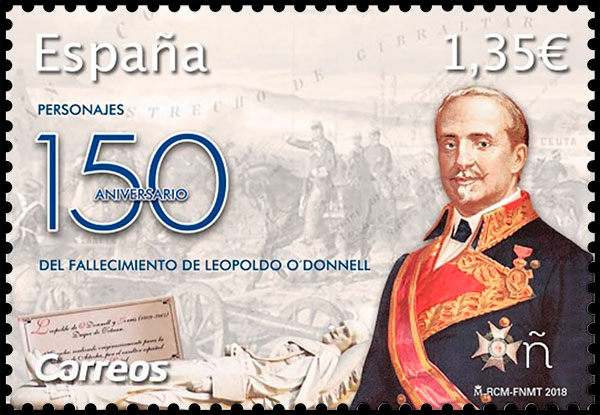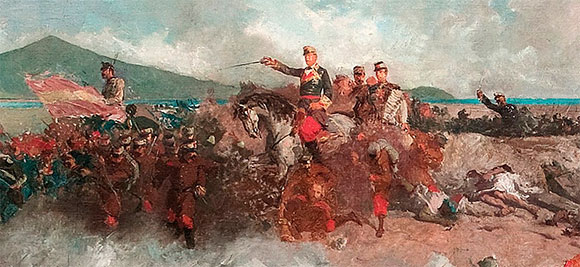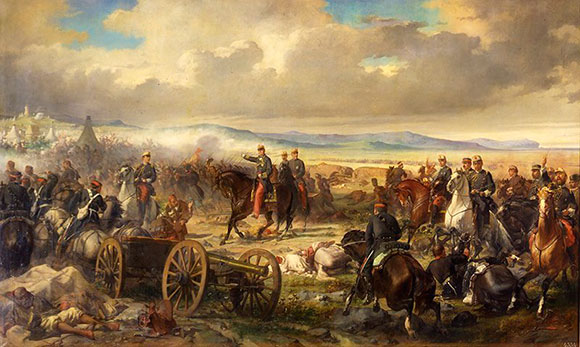
On September 21, 2018, the Spanish Post issued a postage stampto honour the 150th anniversary of the death of of General Leopoldo O’Donnell y Jorris (1809-1867).
He was a military constitutionalist and liberal politician of historical significance in 19th-Century Spain. He served as a soldier in the First Carlist War, where he achieved successive promotions to become a General. He was the Captain-General of Havana and Director General of Infantry. During the Hispano-Moroccan War (1859) he was in charge of the Field Army which took control of Tetuan, thereby gaining the title of Duke of Tetuan and Grandee of Spain.
As a politician he was a senator, War Minister and Prime Minister on several occasions. As Prime Minister it is important to highlight his second period (1858-1863), which was characterised by an economic boom, the expansion of the railways, construction of public projects and diverse administrative improvements.
The mortal remains of Leopoldo O’Donnell were kept in the Basilica of Atocha in Madrid until 1870 when they were moved to the Santa Barbara church in the Salesas Reales Convent, also in Madrid. Since then, his remains have been in a neo-renaissance-style mausoleum made from Carrara marble by the sculptor Jerónimo Suñol.
The stamp depicts an image of Leopoldo O’Donnell wearing the General Officer uniform, (royal blue dress coat with lapel, red collar and gold braids), as well as the Grand Laureate Cross of the Royal and Military Order of Saint Ferdinand, with the band of red ribbon with orange threads on the ends and the reverent Medal of the Order.
On the official website of the Spanish Post, the description of the stamp indicates that the battle for Tetouan (1862), a famous painting by the Spanish painter Maria Fortuny, served as the background for the stamp. This giant battle canvas of 9.7 x 3 meters was ordered by the authorities of Barcelona in honor of the victory in the 1860th year.

However, upon careful examination of the reproduction of the painting by Maria Fortuny (Maria Fortuny) I could not find a single fragment that would correspond to the background pattern of the postage stamp. Everything is different: a different composition, another horse posture, satellites of the general, a gun in the foreground - all this made me continue my search.
As a result, it turned out that the background for the brand really served as a picture of the Battle of Tetouan, but owned by another artist Francesc Sans i Cabot. The painting “The Battle of Tetuan” is kept in the Museum of the Armed Forces in Toledo.

The Battle of Tétouan (Spanish Tetuán) was fought in 1860, near Tétouan, Morocco, between a Spanish army sent to North Africa and the tribal levies which at the time made up the Moroccan Army. The battle was part of the Spanish-Moroccan War of 1859-1860.
The Spanish expeditionary force, which departed from Algeciras, was composed of 36,000 men, 65 pieces of artillery, and 41 ships, which included steamships, sailboats, and smaller vessels. General Leopoldo O'Donnell, 1st Conde de Lucena (later created Duque de Tetuán), a future Prime Minister of Spain, personally took charge of the expedition and divided these forces into three corps.
The capture of Tétouan prevented further attacks on Ceuta and Melilla by Moroccan forces. The Conde de Lucena returned with his troops to Spain; they camped at a spot north of Madrid while a triumphal entry into the capital was arranged. The camp, which acquired permanent structures as well as shops over time, became the Madrid neighbourhood known as Tetuán de las Victorias. In the aftermath of the battle, General Leopoldo O'Donnell, 1st Conde de Lucena, was elevated in the Spanish peerage to being The 1st Duque de Tetuán. He later served as President of the Council of Ministers (also known as the Prime Minister).
Sourse: www.correos.es


